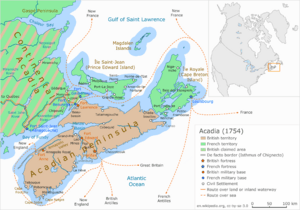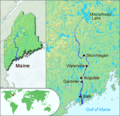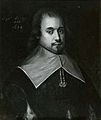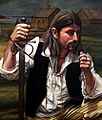Acadia facts for kids
Quick facts for kids Acadia
Acadie
|
|||||||||||||||||
|---|---|---|---|---|---|---|---|---|---|---|---|---|---|---|---|---|---|
| Division of New France | |||||||||||||||||
| 1604–1713 | |||||||||||||||||
|
Flag
|
|||||||||||||||||
 Acadia (1754) |
|||||||||||||||||
| Capital | Undetermined; Port-Royal (de facto) |
||||||||||||||||
| History | |||||||||||||||||
|
• Established
|
1604 | ||||||||||||||||
| 1713 | |||||||||||||||||
|
|||||||||||||||||
Acadia (in the French language Acadie) was the name given to lands in a portion of the French colonial empire of New France, in northeastern North America that included parts of eastern Quebec, the Maritime provinces, and modern-day Maine to the Kennebec River. During much of the 17th century and early 18th century, Norridgewock on the Kennebec River and Castine at the end of the Penobscot River were the southern-most settlements of Acadia. The actual specification by the French government for the territory refers to lands bordering the Atlantic coast, roughly between the 40th and 46th parallels. Later, the territory was divided into the British colonies which became Canadian provinces and American states.
The first capital of Acadia, established in 1605, was Port-Royal. A British force from Virginia attacked and burned the town in 1613 but it was later rebuilt nearby, where it remained the capital of French Acadia until the British conquest of Acadia in 1710.
Today, Acadia is used to refer to regions of North America that are historically associated with the lands, descendants, and/or culture of the former French region. It particularly refers to regions of The Maritimes with French roots, language, and culture, primarily in New Brunswick, Nova Scotia, the Magdalen Islands and Prince Edward Island, as well as in Maine. It can also be used to refer to the Acadian diaspora in southern Louisiana, a region also referred to as Acadiana. In the abstract, Acadia refers to the existence of a French culture in any of these regions.
People living in Acadia, and sometimes former residents and their descendants, are called Acadians, also later known as Cajuns after resettlement in Louisiana.
Images for kids
-
The French claimed that the Kennebec River formed the border between Acadia and New England, seen here on a map of Maine
-
Siege of Saint John (1645) – d'Aulnay defeats La Tour in Acadia
-
Duc d'Anville Expedition: Action between HMS Nottingham and the Mars
-
Acadians at Annapolis Royal, by Samuel Scott, 1751; earliest known image of Acadians
-
St. John River Campaign: A View of the Plundering and Burning of the City of Grimross (present day Gagetown, New Brunswick) by Thomas Davies in 1758. This is the only contemporaneous image of the Expulsion of the Acadians.
-
Daniel d'Auger de Subercase, last governor of Acadia 1706–1710
See also
 In Spanish: Acadia para niños
In Spanish: Acadia para niños





















